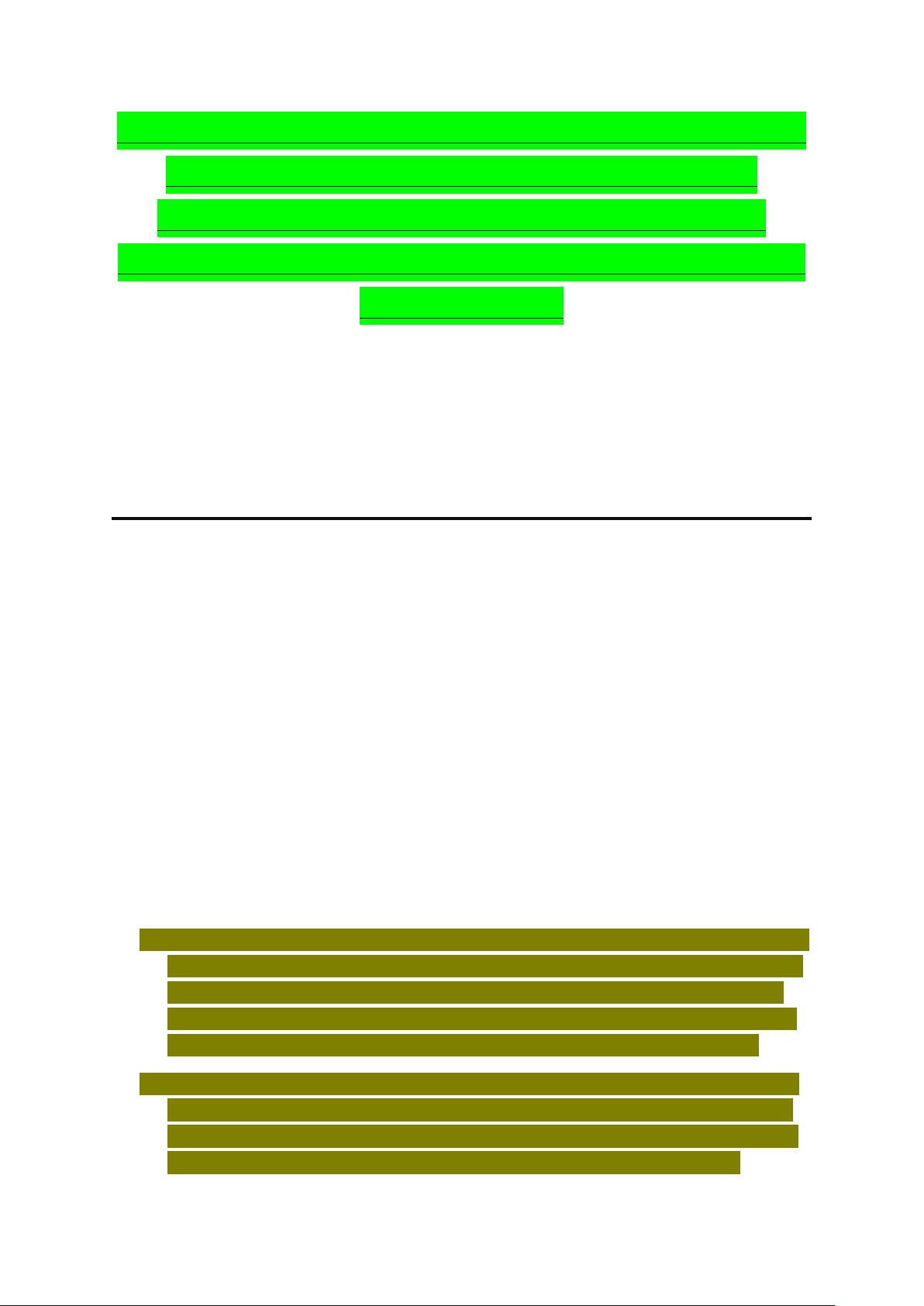
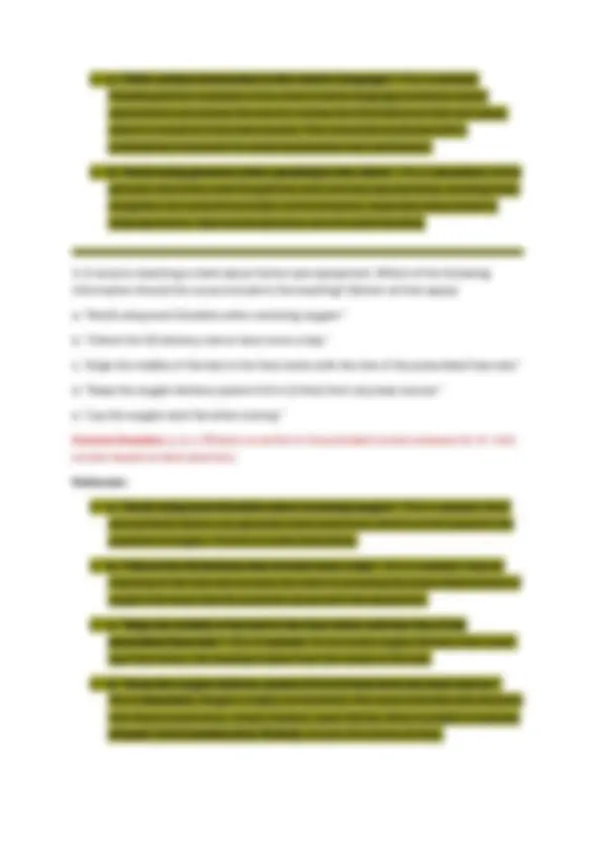

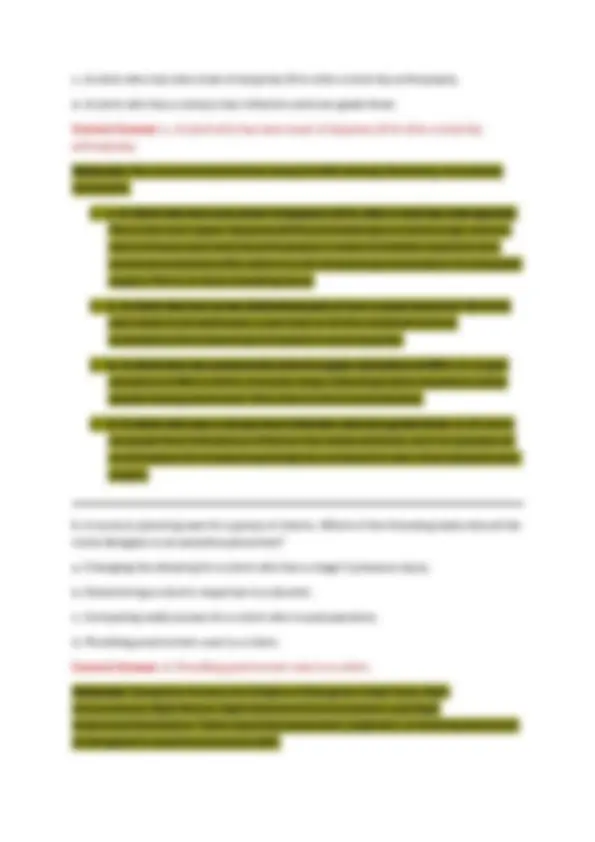
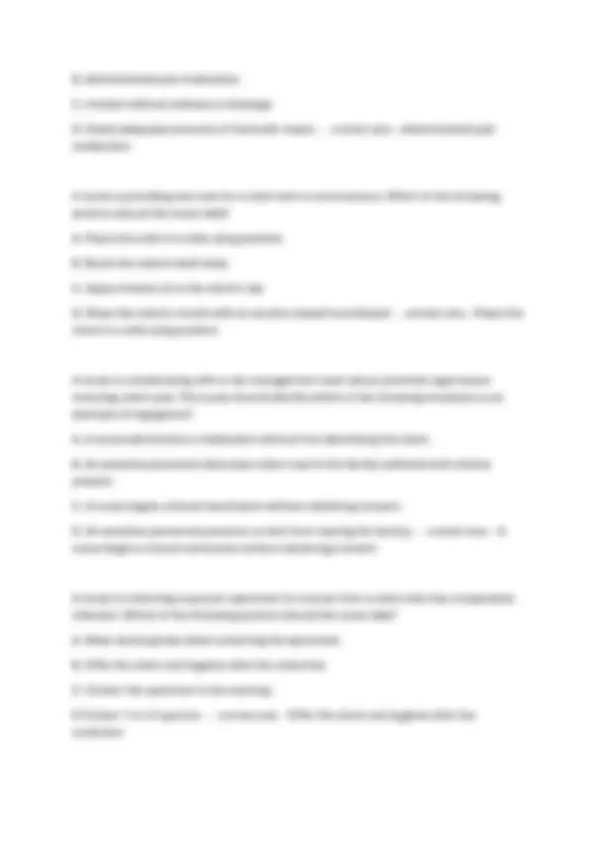
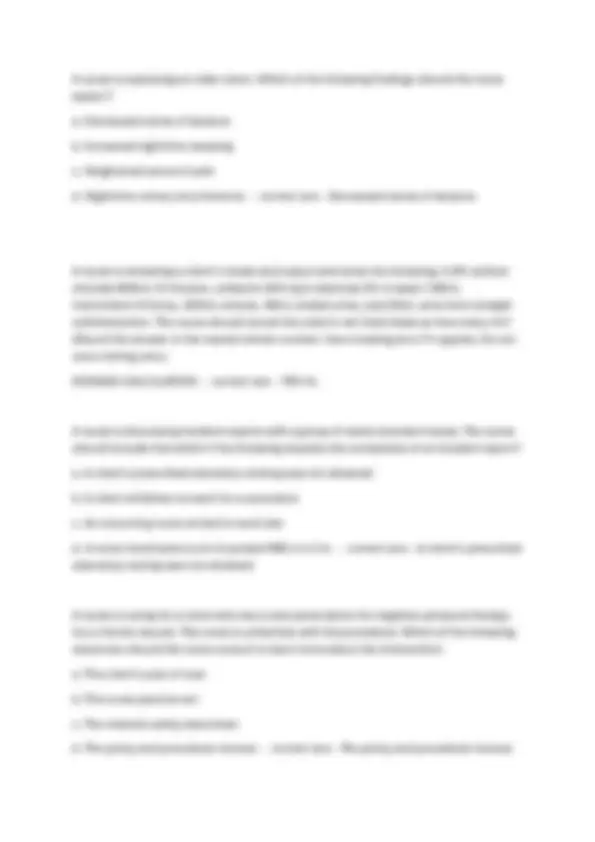
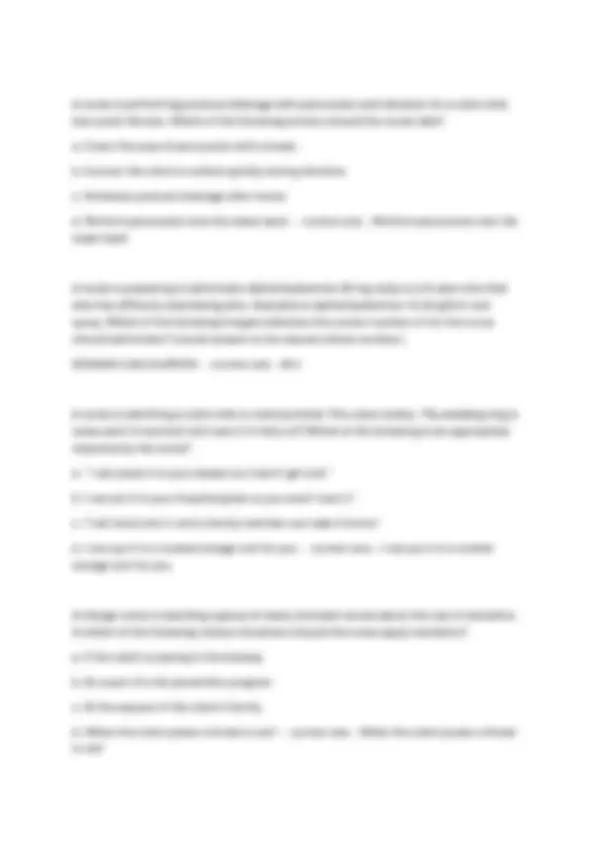
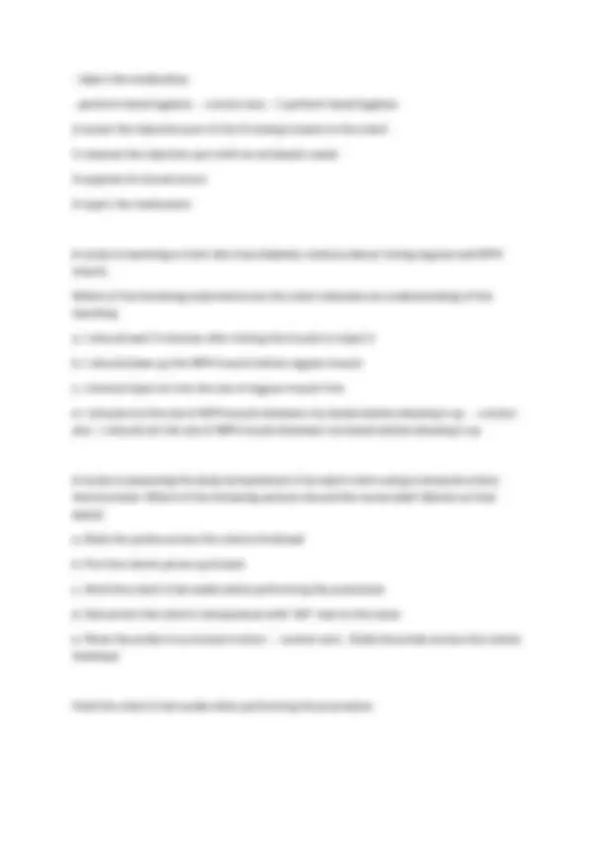
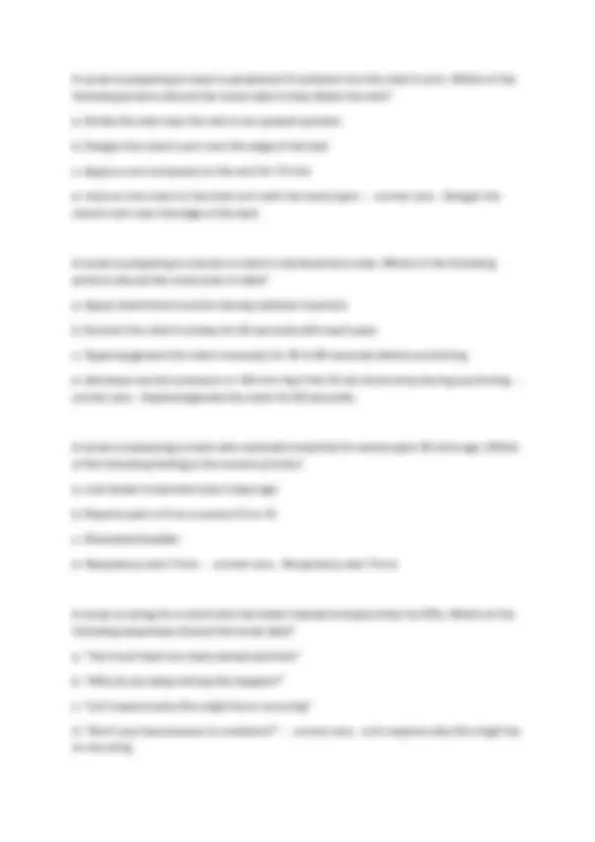
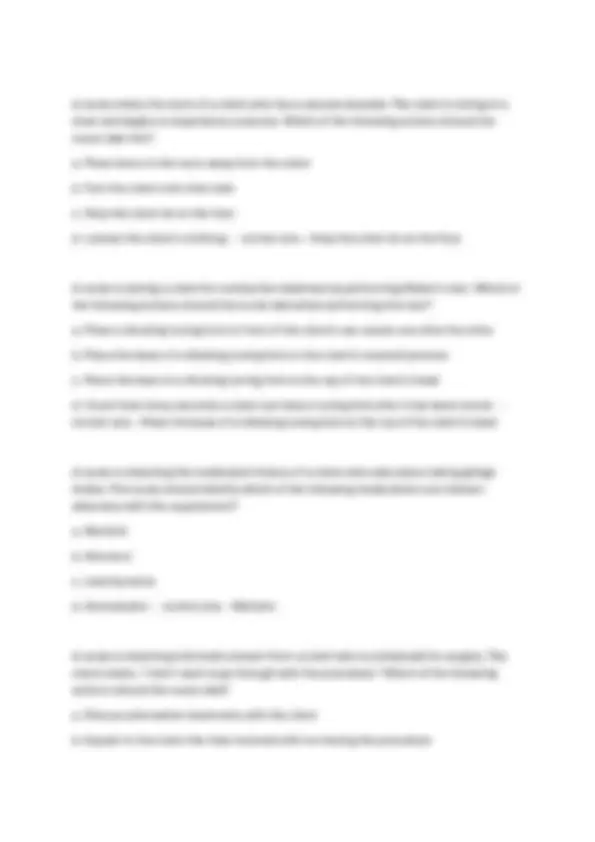
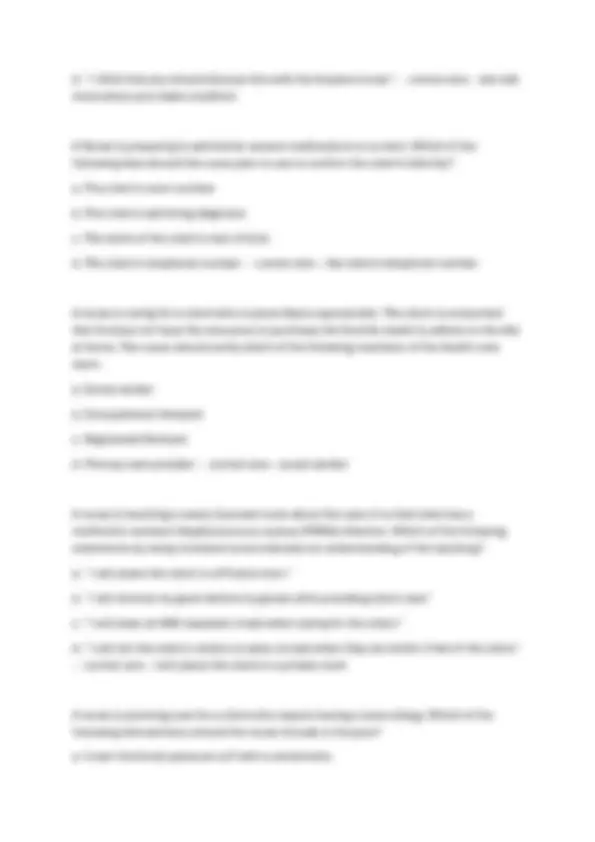
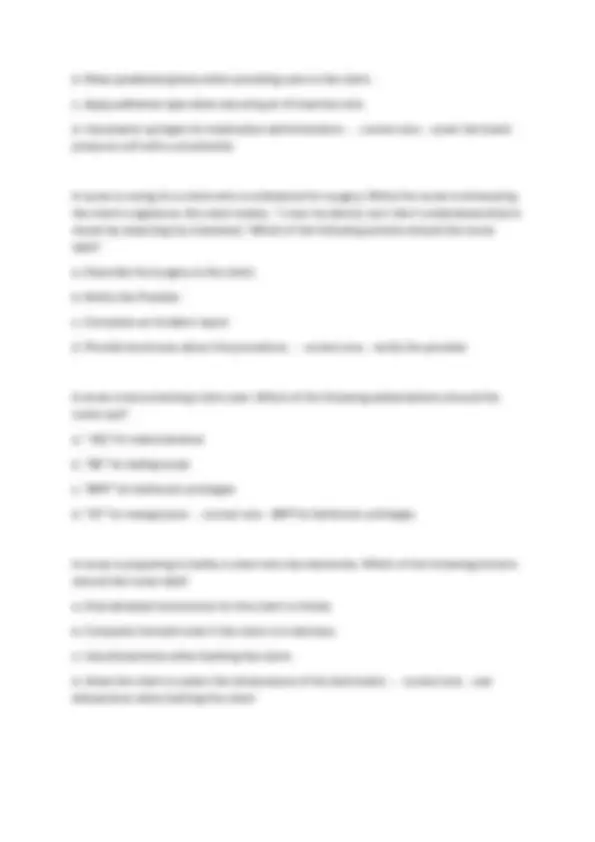
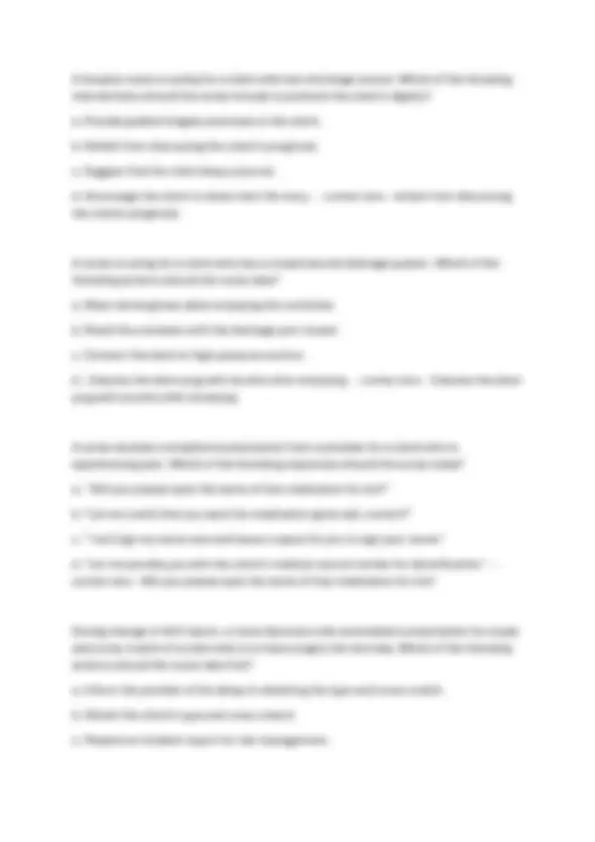
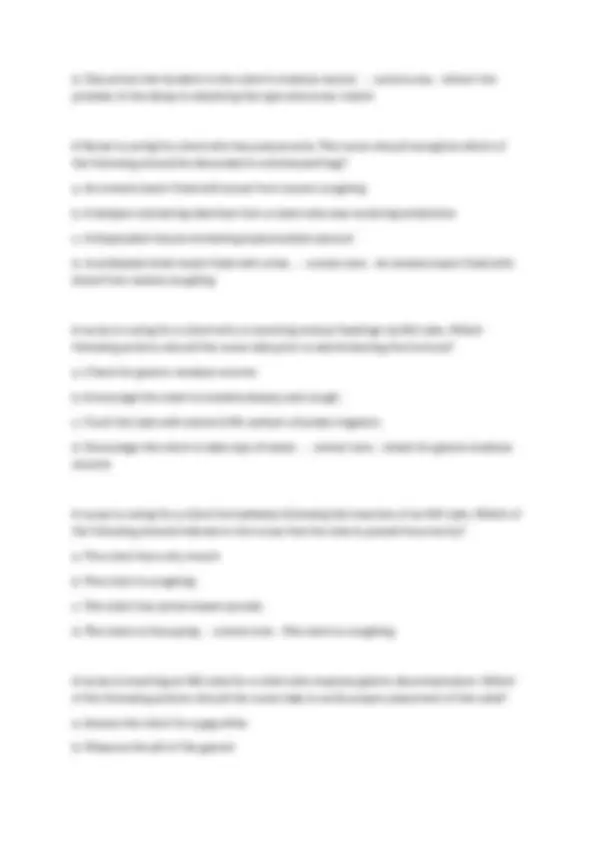
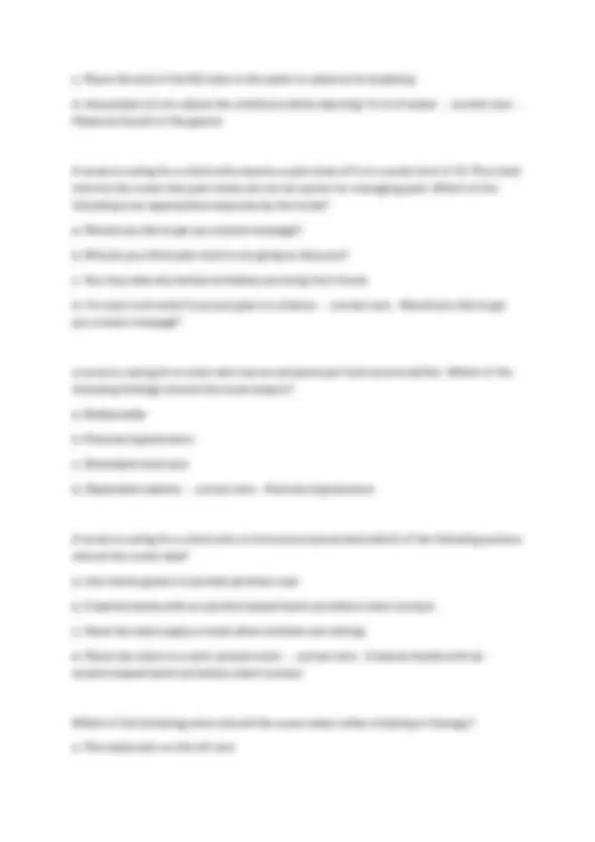
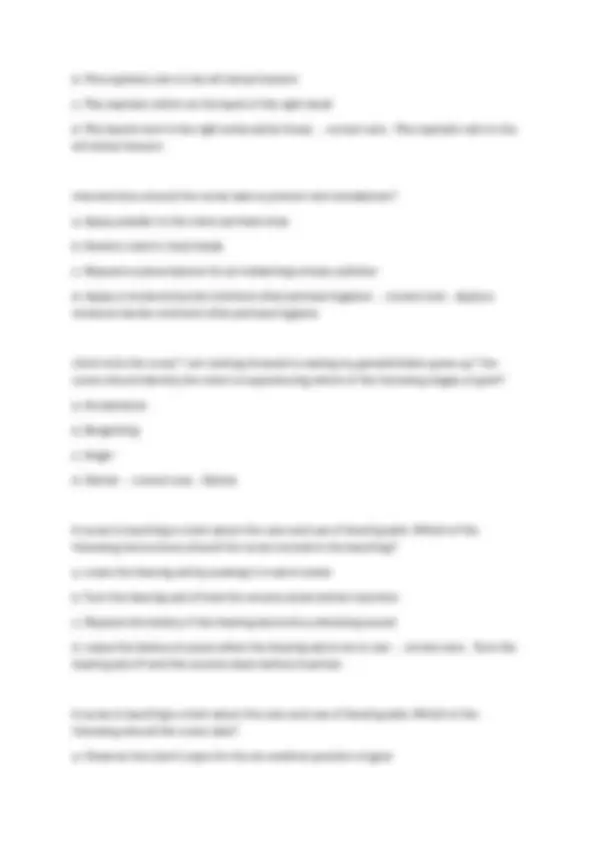
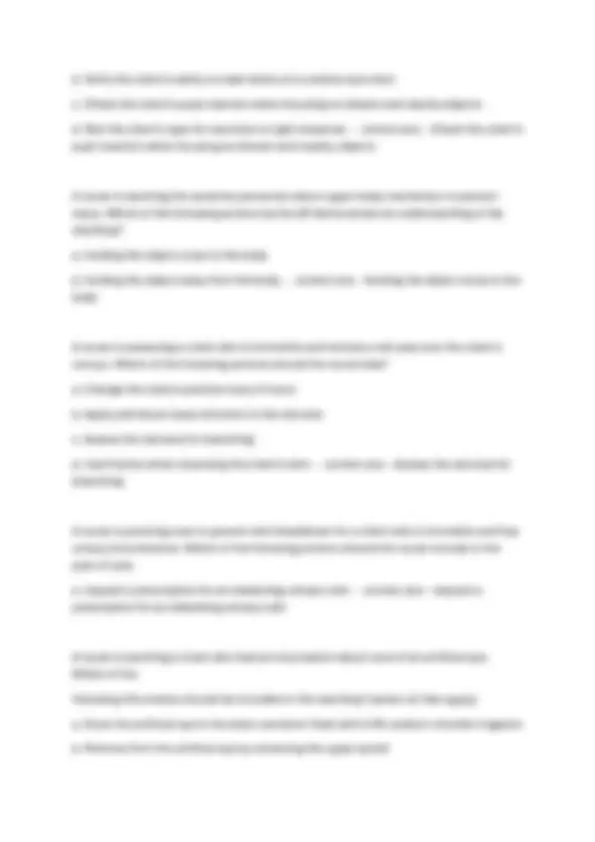
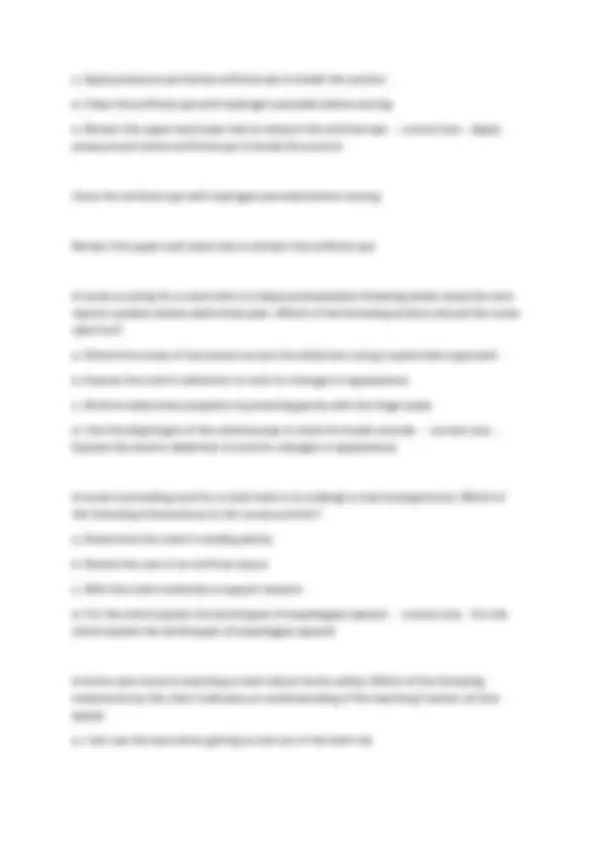
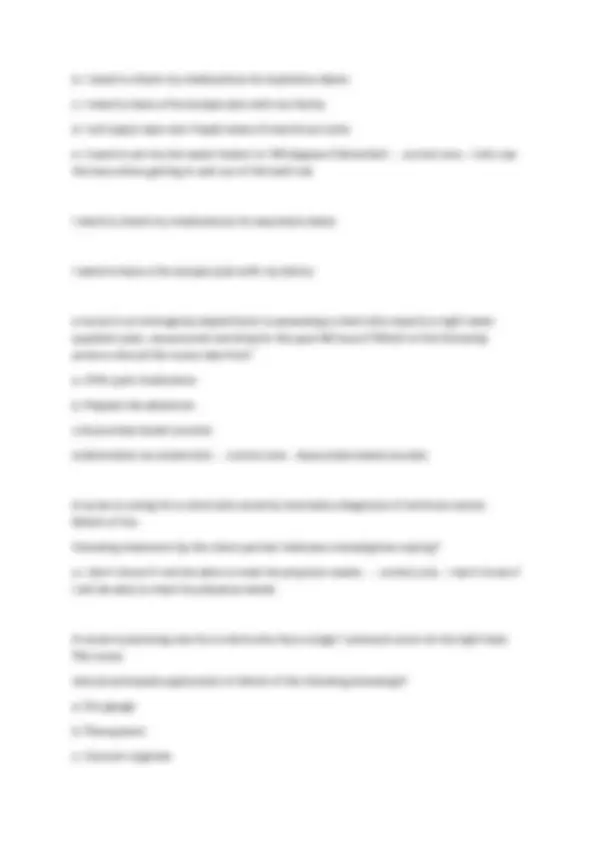
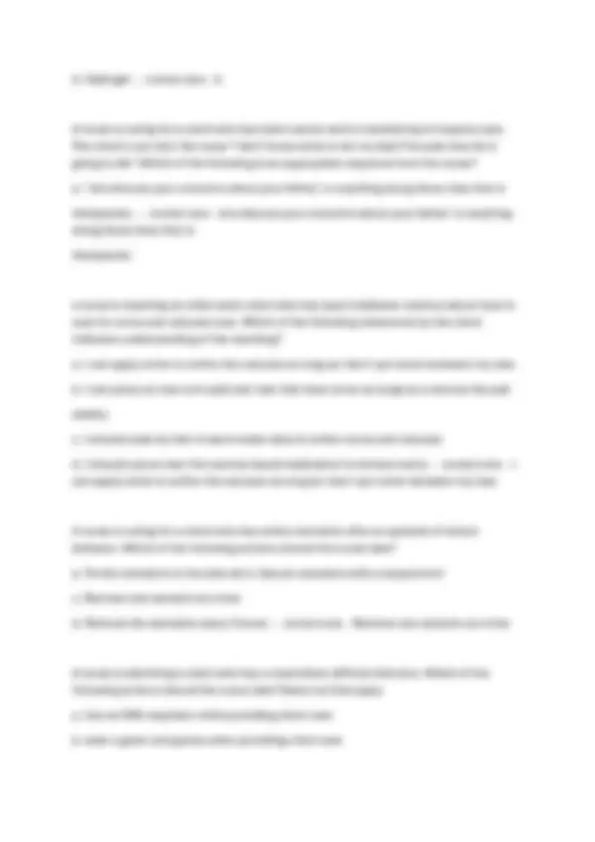
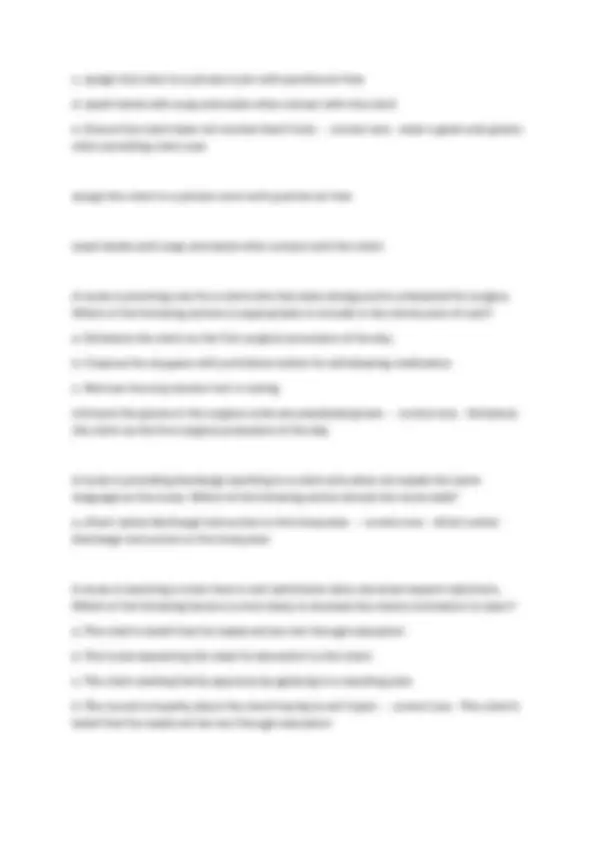
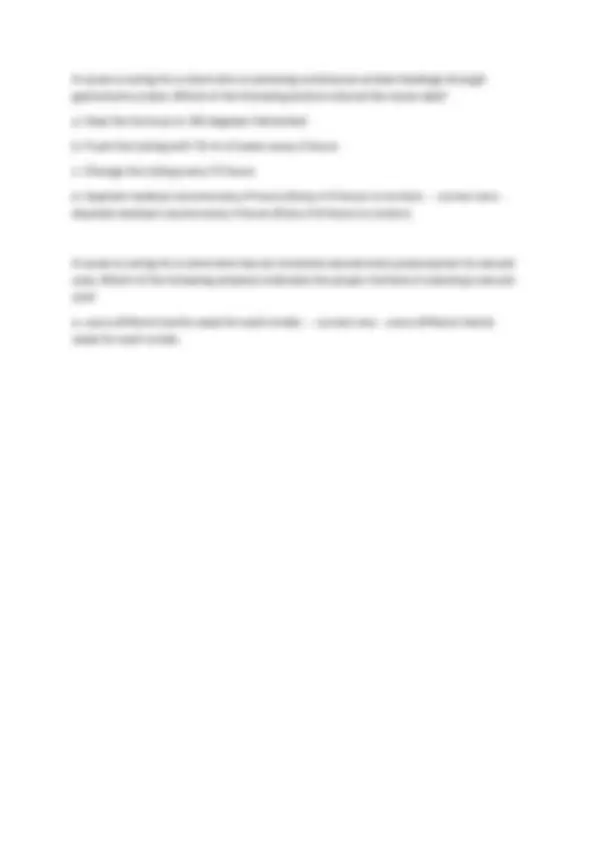


Study with the several resources on Docsity

Earn points by helping other students or get them with a premium plan


Prepare for your exams
Study with the several resources on Docsity

Earn points to download
Earn points by helping other students or get them with a premium plan
Community
Ask the community for help and clear up your study doubts
Discover the best universities in your country according to Docsity users
Free resources
Download our free guides on studying techniques, anxiety management strategies, and thesis advice from Docsity tutors
A.T.I 2025 Fundamentals Proctored Exam & Retake Study Guide: Updated Practice Questions, Proctor-Approved Answers, and Test-Taking Strategies to Pass ATI FUNDAMENTALS PROCTOR on the First Try
Typology: Exams
1 / 29

This page cannot be seen from the preview
Don't miss anything!






















Here are the multiple-choice questions with rationales and indicated correct answers for the provided list.
c. A client who has new onset of dyspnea 24 hr after a total hip arthroplasty. d. A client who has a urinary tract infection and low-grade fever. Correct Answer: c. A client who has new onset of dyspnea 24 hr after a total hip arthroplasty. Rationale: The nurse should prioritize using the ABC (Airway, Breathing, Circulation) framework.
D. Place the client in a negative airflow room. - - correct ans- - Wear a mask when working within 3 feet of the client A nurse obtains a prescription for wrist restraints for a client who is trying to pull out his NG tube. Which of the following actions should the nurse take? A. Attach the restraints securely to the side rails of the client's bed. B. Apply the restraints to allow as little movement as possible C.Allow room for two fingers to fit between the clients skin and the restraints d. remove the restraints every 4 hours - - correct ans- - Allow room for two fingers to fit between the clients skin and the restraints A nurse is admitting a client who has tuberculosis. Which of the following types of transmission precautions should the nurse plan to initiate? A. Droplet B. Airborne c. protective environment d. contact - - correct ans- - Airborne A nurse in a well-child clinic receives a telephone call from a parent who states that their child accidentally swallowed paint thinner. The child is awake and alert. Which of the following responses should the nurse make? A. Have your child drink one large glass of water. B. Hang up and call a poison control center hotline. C. Bring your child into the clinic later today. D. Induce vomiting in your child with syrup of ipecac. - - correct ans- - Have your child drink one large glass of water A nurse is documenting a client's medical record. Which of the following entries should the nurse record. A. Oral temperature slightly elevated at 0800
B. Administered pain medication C. Incision without redness or drainage D. Drank adequate amounts of fluid with meals. - - correct ans- - Administered pain medication A nurse is providing oral care for a client who is unconscious. Which of the following actions should the nurse take? A. Place the client in a side-lying position. B. Brush the clients teeth daily C. Apply mineral oil to the client's lips D. Rinse the client's mouth with an alcohol-based mouthwash - - correct ans- - Place the client in a side-lying position A nurse is collaborating with a risk management team about potential legal issues involving client care. The nurse should identify which of the following situations is an example of negligence? A. A nurse administers a medication without first identifying the client. B. An assistive personnel discusses client care in the facility cafeteria with visitors present. C. A nurse begins a blood transfusion without obtaining consent. D. An assistive personnel prevents a client from leaving the facility. - - correct ans- - A nurse begins a blood transfusion without obtaining consent A nurse is collecting a sputum specimen for culture from a client who has a respiratory infection. Which of the following actions should the nurse take? A. Wear sterile gloves when collecting the specimen. B. Offer the client oral hygiene after the collection C. Collect the specimen in the evening. D Collect 1 ml of sputum. - - correct ans- - Offer the client oral hygiene after the collection
A nurse is performing postural drainage with percussion and vibration for a client who has cystic fibrosis. Which of the following actions should the nurse take? a. Cover the area of percussion with a towel. b. Instruct the client to exhale quickly during vibration c. Schedule postural drainage after meals d. Perform percussion over the lower back - - correct ans- - Perform percussion over the lower back A nurse is preparing to administer diphenhydramine 20 mg orally to a 6-year-old child who has difficulty swallowing pills. Available is diphenhydramine 12.5mg/5ml oral syrup. Which of the following images indicates the correct number of mL the nurse should administer? (round answer to the nearest whole number.) DOSAGE CALCULATION - - correct ans- - 8ml A nurse is admitting a client who is malnourished. The client states, "My wedding ring is loose and I'm worried I will lose it if it falls off."Which of the following is an appropriate response by the nurse? a. " I will place it in your drawer so it won't get lost." b. I can pin it to your hospital gown so you won't lose it." c. "I will hold onto it until a family member can take it home." d. I can put it in a locked storage unit for you - - correct ans- - I can put it in a locked storage unit for you A charge nurse is teaching a group of newly licensed nurses about the use of restraints. In which of the following clinical situations should the nurse apply restraints? a. If the client is pacing in the hallway b. As a part of a fall prevention program c. At the request of the client's family d. When the client poses a threat to self - - correct ans- - When the client poses a threat to self
To ensure client safety, a nurse manager is planning to observe a newly licensed nurse perform a straight catheterization on a client. In which of the following roles is the nurse manager functioning? a. Case manager b. Client educator c. Client care provider d. Client advocate - - correct ans- - Client advocate A charge nurse in a long-term care facility is preparing an educational program about delirium for newly hired nurses. Which of the following statements should the nurse plan to include? a. "Delirium does not affect a client's perception of her environment." b. "Delirium does not affect a client's sleep cycle." c. "Delirium has an abrupt onset." d. "Delirium has a slow progression." - - correct ans- - Delirium has an abrupt onset A nurse is speaking with a client who has recently received a diagnosis of a chronic illness. The client states, " The doctor must be wrong. I can't be that sick". The nurse should inform the client that their reaction is an example of which of the following expected responses to grief? a. Acceptance b. Denial c. Anger d. Depression - - correct ans- - Denial A Nurse on a medical-surgical unit is providing care for four clients. The nurse should identify which of the following situations as an ethical dilemma? a. A surgeon who removed the wrong kidney during a surgical procedure refuses to take responsibility for her actions
A nurse is preparing to insert a peripheral IV catheter into the client's arm. Which of the following actions should the nurse take to help dilate the vein? a. Stroke the skin near the vein in an upward position b. Dangle the client's arm over the edge of the bed c. Apply a cool compress to the vein for 10 min d. Instruct the client to flex their arm with the hand open - - correct ans- - Dangle the client's arm over the edge of the bed A nurse is preparing to suction a client's tracheostomy tube. Which of the following actions should the nurse plan to take? a. Apply intermittent suction during catheter insertion b. Suction the client's airway for 20 seconds with each pass c. Hyperoxygenate the client manually for 30 to 60 seconds before suctioning d. decrease suction pressure to 150 mm Hg if the O2 sat levels drop during suctioning - - correct ans- - Hyperoxegenate the client for 60 seconds. A nurse is assessing a client who received morphine for severe pain 30 mins ago. Which of the following finding is the nurse's priority? a. Last bowel movement was 3 days ago b. Reports pain of 8 on a scale of 0 to 10 c. Distended bladder d. Respiratory rate 7/min - - correct ans- - Respiratory rate 7/min A nurse is caring for a client who has been treated multiple times for STIs. Which of the following responses should the nurse take? a. "You must have too many sexual partners" b. "Why do you keep letting this happen?" c. "Let's explore why this might be re-occuring" d. "Don't you have access to condoms?" - - correct ans- - Let's explore why this might be re-occuring
c. Express approval of the client's decision to not have the procedure d. Document the client's decision in the medical record - - correct ans- - Document the clients decision in the medical record A nurse is providing teaching to a client about reducing the adverse effects of immobility. Which of the following statements by the client indicates an understanding of the teaching? a. " I will have my partner help me change position every 4 hours" b. " I will remove my antiembolic stockings while I am in bed" c." I will hold my breath when rising from a sitting position" d." I will perform ankle and knee exercises every hour." - - correct ans- - I will perform ankle and knee exercises every hour A nurse is caring for a client who is postoperative and has a new prescription to advance her diet to full liquids. Which of the following foods should the nurse offer the client as a part of a full liquid diet? a. Oatmeal b. Applesauce c. Scrambled eggs d. Plain Yogurt - - correct ans- - Plain yogurt A nurse is preparing a client who has terminal cancer for discharge. Which of the following questions should the nurse ask when assessing the client's psychosocial history? a. " What medications are you currently taking?" b." Are you experiencing any Pain?" c. " Have any of your relatives been diagnosed with cancer?" d. " What Techniques do you use to cope with stress?" - - correct ans- - What techniques do you use to cope with stress?
A nurse is performing a skin assessment on an older adult client. Which of the following findings should the nurse expect? a. Thickened outer layer of skin b. Increased skin elasticity c. Reduced sweat production d. Increased Production of oils - - correct ans- - Reduced sweat production A nurse is caring for a client who begins to cry after receiving a diagnosis of cancer. Which of the following responses should the nurse make? a. " I would get a second opinion if I were you." b " it might seem bad now, but things will get better." c " it must be difficult for you to receive this kind of news." d I think you would benefit from speaking with our chaplain." - - correct ans- - it must be difficult for you to receive this kind of news A nurse is preparing to obtain a health history from a client. Which of the following actions should the nurse take? a. Use the client's first name when initially meeting the client. b. Tell the client the purpose for collecting the information. c. Explain to the client the necessity of full disclosure of information. d. Avoid documenting direct quotes from the client as part of subjective data. - - correct ans- - tell the client the purpose for collecting the information A nurse is caring for a client who has brain cancer and is transferring to hospice care. The client's son tells the nurse, " I don't know what to tell my dad if he asks how he is going to die." Which of the following is an appropriate response by the nurse? a. " Let's talk more about your dad's condition." b. "The social worker will help you answer those questions." c. " Try to help your dad enjoy this time as much as he can."
b. Wear powdered gloves when providing care to the client. c. Apply adhesive tape when securing an IV insertion site. d. Use plastic syringes for medication administration. - - correct ans- - cover the blood pressure cuff with a stockinette A nurse is caring for a client who is scheduled for surgery. While the nurse is witnessing the client's signature, the client states, " I trust my doctor, but I don't understand what is meant by resecting my intestines." Which of the following actions should the nurse take? a. Describe the surgery to the client. b. Notify the Provider. c. Complete an incident report d. Provide brochures about the procedure. - - correct ans- - notify the provider A nurse is documenting client care. Which of the following abbreviations should the nurse use? a. " SQ" for subcutaneous b. "SS" for sliding scale c. "BRP" for bathroom privileges d. "OJ" for orange juice - - correct ans- - BRP for bathroom privileges A nurse is preparing to bathe a client who has dementia. Which of the following actions should the nurse take? a. Give detailed instructions for the client to follow. b. Complete the bath even if the client is in distress. c. Use distractions when bathing the client. d. Allow the client to select the temperature of the bath water. - - correct ans- - use distractions when bathing the client
A hospice nurse is caring for a client who has end stage cancer. Which of the following interventions should the nurse include to promote the client's dignity? a. Provide guided imagery exercises to the client. b. Refrain from discussing the client's prognosis c. Suggest that the client keep a journal. d. Encourage the client to share their life story. - - correct ans- - refrain from discussing the clients prognosis A nurse is caring for a client who has a closed wound drainage system. Which of the following actions should the nurse take? a. Wear sterile gloves when emptying the container. b. Reset the container with the drainage port closed c. Connect the drain to high pressure suction. d. .Cleanse the drain plug with alcohol after emptying - - correct ans- - Cleanse the drain plug with alcohol after emptying A nurse receives a telephone prescription from a provider for a client who is experiencing pain. Which of the following responses should the nurse make? a. " Will you please spell the name of that medication for me?" b. "Let me clarify that you want the medication given qid, correct?" c. " I will sign my name now and leave a space for you to sign your name." d. "Let me provide you with the client's medical record number for identification." - - correct ans- - Will you please spell the name of that medication for me? During change of shift report, a nurse discovers she overlooked a prescription for a type and cross-match of a client who is to have surgery the next day. Which of the following actions should the nurse take first? a. Inform the provider of the delay in obtaining the type and cross-match. b. Obtain the client's type and cross-match. c. Prepare an incident report for risk management.